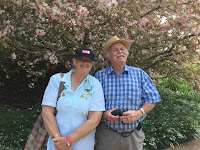Mayfield Garden is a work-in- progress series of gardens, 15 hectares in all, open most days of the year – just bring your strong legs & walking shoes. This garden includes a 2.5 ha water garden, boardwalks, huge bluestone bridge, 'the grotto' (cascading waterfall you can walk behind), copper tree fountain, beautiful trees & gardens and much more.
Before we continued on our voyage of discovery we welcomed Chloe & Kayla, Jude & Wazza’s cute
granddaughters and then shared our gardening woes & wows. Jude & Wazza have been going to Bunnings’ garden club at Goulburn on the last Thursday of the month at 6pm and are learning heaps (as in compost heaps?).
They added liquid sulphate after 'wettasoil' and their blueberries are now growing well in pots. Grow lettuce in semi-shade and they won’t bolt to seed.
 Doreen said their weeds are still growing thickly but Bruce has had success growing roses from cuttings in his hothouse using his own potting mix (better than what he bought). He just needs to keep water up – suggestion was to put saucers under pots.
Doreen said their weeds are still growing thickly but Bruce has had success growing roses from cuttings in his hothouse using his own potting mix (better than what he bought). He just needs to keep water up – suggestion was to put saucers under pots.Kevin & Margaret are growing tops not bottoms on carrots (if only I had that body). They say to put pine needles around blueberries. Azaleas, camellias & rhododendrons are also acid lovers and like pine or casuarinas needles.
 Caroline & John are picking “branching broccoli” (bought at the big B), carrots & lettuce. Joy has the best crop of yellow thistles! Anne is having problems with her lemons – thick skin & very dry despite plenty of watering.
Caroline & John are picking “branching broccoli” (bought at the big B), carrots & lettuce. Joy has the best crop of yellow thistles! Anne is having problems with her lemons – thick skin & very dry despite plenty of watering.Prune lemons later in November after risk of frost has passed – clean secateurs with metho. Bridget’s broccoli, cabbage & Chinese cabbage have all bolted – probably getting too much sun – need more shade. These veggies can also bolt if cold weather suddenly turns hot. Wazza said that Yates garden products website has an “app” you can download for gardening problems or what is that plant?
Katie has flowers everywhere and leaves on trees - she’s picking bok choy, kale, snowpeas & lemons so she says she’s happy. Only problem – the roses in her garden are choking with couch grass which she’s poisoned, and while waiting for the grass to die down she’s working out which mattock or sledge hammer she can use to batter it out. Irene’s lemon is still really sick but broadbeans are flowering and peas growing. Liz-Ann & Peter are delighted that the horseradish they planted months ago is surviving despite being completely neglected.
After our marathon garden walk, many of us had lunch at the old, very basic & ordinary looking Tourist Hotel in Oberon – but great $10 pub lunches. One not-very- young woman serves behind the bar, takes orders, cooks all meals and then serves them &clears up (she really is chief cook & bottle washer).
We had a lot of fun and everyone enjoyed their meal.
Our next meeting will be at John & Caroline Engisch’s Melbourne Cup Day, Tuesday 7 th
November after 11am-ish (later than usual). Please bring something to BBQ as well as a plate of either salad or
sweets to share – don’t forget your crazy hat and gold coins for sweeps!









